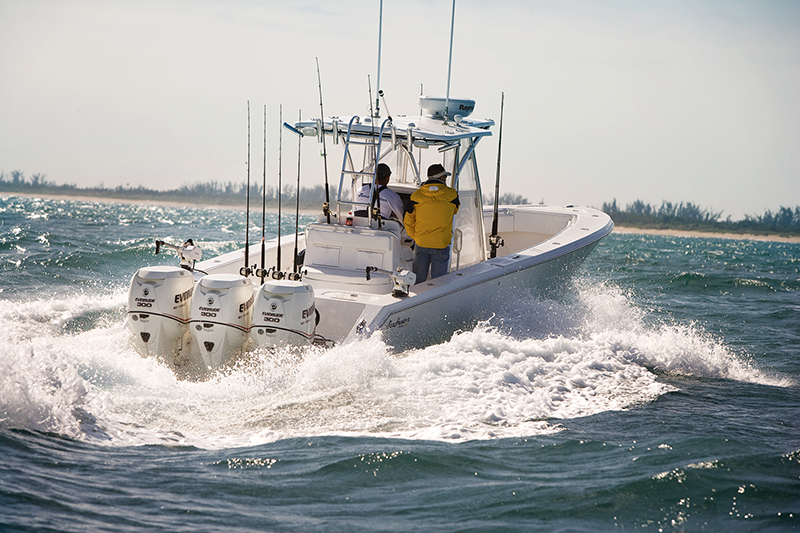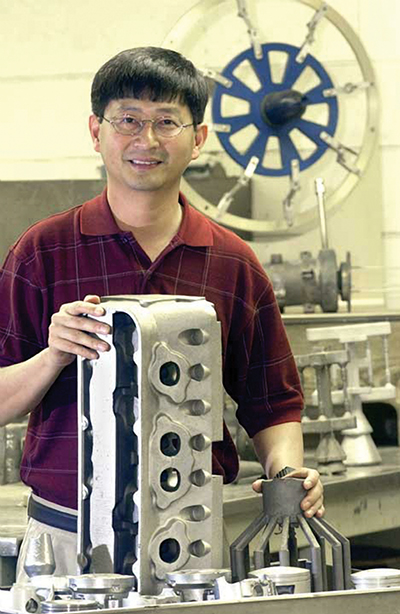
Outboard Motor Maximizes Power and Dependability
Originating Technology/NASA Contribution
Developed by Jonathan Lee, a structural materials engineer at Marshall Space Flight Center, and PoShou Chen, a scientist with Huntsville, Alabama-based Morgan Research Corporation, MSFC-398 is a high-strength aluminum alloy able to operate at high temperatures. The invention was conceived through a program with the Federal government and a major automobile manufacturer called the Partnership for Next Generation Vehicles. While the success of MSFC-398 can partly be attributed to its strength and resistance to wear, another key aspect is the manufacturing process: the metal is capable of being produced in high volumes at low cost, making it attractive to commercial markets.
Since its premiere, the high-strength aluminum alloy has received several accolades, including being named Marshall’s “Invention of the Year” in 2003, receiving the Society of Automotive Engineering’s “Environmental Excellence in Transportation Award” in 2004, the Southeast Regional Federal Laboratory Consortium “Excellence in Technology Transfer Award” in 2005, and the National Federal Laboratory Consortium’s “Excellence in Technology Transfer Award” in 2006.
Realizing the potential commercial applicability of MSFC-398, Marshall introduced it for public licensing in 2001. The alloy’s subsequent success is particularly apparent in its widespread application in commercial marine products.
Partnership
A worldwide leader in the design, development, and distribution of a wide variety of land and water vehicles, including outboard motors, Bombardier Recreational Products (BRP) Inc., came across a description of the NASA alloy and was immediately intrigued. The Canada-based company decided to meet with NASA in April 2001, to explore how the technology could strengthen its products. BRP and NASA identified an application for high-performance outboard engine pistons. Prototype production started in July, and the Boats and Outboard Engines Division of BRP, based in Sturtevant, Wisconsin, signed the licensing agreement exactly 1 year later.
“Having a proper mixture of the alloy’s composition with the correct heat treatment process are two crucial steps to create this alloy for high-temperature applications,” said Lee. “The team at Bombardier worked hard with the casting vendor and NASA inventors to perfect the casting of pistons, learn and repeat the process, and bring its product to market. Chen and I are honored to see something we invented being used in a commercial product in a very rapid pace. We still have to pinch ourselves occasionally to realize that BRP’s commercialization effort for this alloy has become a reality. It’s happened so quickly.”
“The usual cycle for developing this type of technology, from the research stage to the development phase, and finally into a commercial product phase may take several years and more than a $1 million investment,” Lee said. In this case, it occurred in fewer than 4 years and at a fraction of that cost.
BRP also applauded NASA for its prompt assistance. “The demands of the outboard engine are more significant than any other engine NASA had ever encountered,” claims Denis Morin, the company’s vice president of engineering, outboard engines. “The team from NASA was on the fast track, learned all the intricacies, and delivered an outstanding product.” BRP incorporated the alloy pistons into a brand new mid-power outboard motor that the company affirms is “years beyond carbureted two-stroke, four-stroke, or even direct injection” engines.
Product Outcome
While a four-stroke engine generally runs cleaner and quieter than its two-stroke counterpart, it lacks the power and dependability; and the two-stroke engine, which generally contains 200 fewer parts than a comparable four-stroke motor, literally has fewer things that can go wrong. Evinrude E-TEC is a line of two-stroke motors that maintain the power and dependability of a two-stroke with the refinement of a four-stroke. The Evinrude E-TEC is also the first outboard motor that will not require oil changes, winterization, spring tune-ups, or scheduled maintenance for 3 years of normal recreational use. It incorporates the NASA alloy into its pistons, significantly improving durability at high temperatures while also making the engine quieter, cleaner, and more efficient.
The E-TEC features a low-friction design completely free from belts, powerhead gears, cams, and mechanical oil pumps; a “sure-start” ignition system that prevents spark plug fouling and does not require priming or choking; and speed-adjusting failsafe electronics that keep it running even if a boat’s battery dies. A central computer controls the outboard engine’s single injector, which is completely sealed to prevent air from entering the fuel system and thus minimizes evaporative emissions. Furthermore, the E-TEC auto-lubing oil system eliminates the process of having to mix oil with fuel, while complete combustion precludes virtually any oil from escaping into the environment. When programmed to operate on specially designed oil, the E-TEC uses approximately 50 percent less oil than a traditional direct injection system and 75 percent less than a traditional two-stroke engine. Additionally, when compared to a four-stroke engine, the E-TEC creates 80 percent less carbon monoxide while idle.
As an added bonus for fishermen, the new piston design also reduces the slapping sound usually made when pistons slide up and down in the engine’s cylinder, a sure sign to fish that someone is coming for them with a worm on a hook.
Ranging from 40-horsepower (hp) models to 300-hp models, Evinrude E-TEC engines won the prestigious “2003 Innovation Award” from the National Marine Manufacturers Association at the annual Miami International Boat Show, and are the only marine engines to have ever received the U.S. Environmental Protection Agency’s “Clean Air Technology Excellence Award.”
E-TEC also received a testimonial from an individual who put the engine to an incredible test in the most unusual of conditions: While BRP often hears from boaters who depend on its engines in tropical, warm, and temperate climates, the company had heard about an individual from the small Alaskan village of Koyukuk who runs the Yukon River with his Evinrude just about everyday, from break-up of the iced-over body of water to freeze-up during the long Alaskan winter. The nearest “sizable” town is 400 miles upstream from Koyukuk, so the turbid and turgid river serves as the only “highway” on which to acquire goods, tools, and groceries. That’s a pretty good vote of confidence.
Evinrude® is a registered trademark, and E-TEC™ is a trademark of Bombardier Recreational Products Inc.

Jonathan Lee, a structural materials engineer at Marshall Space Flight Center was on the team that developed MSFC-398, a high-strength aluminum alloy now being used in high-performance marine outboard engines.

The Evinrude E-TEC line of outboard engines uses a NASA-derived aluminum alloy.













